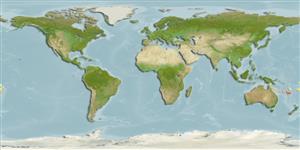>
Syngnathiformes (Pipefishes and seahorses) >
Syngnathidae (Pipefishes and seahorses) > Syngnathinae
Etymology: Hippocampus: Greek, ippos = horse + Greek,kampe = curvature (Ref. 45335); curvicuspis: Name from the Latin 'curvus' for curved and 'cuspis' for spine; referring to the curved spines, including the nape spine and several spines on the superior and lateral trunk ridges..
More on author: Fricke.
Issue
This species is a synonym of Hippocampus hystrix Weber, 1913 according to Lourie et al., 2016 (Ref. 115213). This species record will be removed.
Environment: milieu / climate zone / depth range / distribution range
Écologie
marin démersal; non migrateur; profondeur 6 - 20 m (Ref. 86942). Tropical
Distribution
Pays | Zones FAO | Écosystèmes | Occurrences | Point map | Introductions | Faunafri
Western Pacific: New Caledonia.
Taille / Poids / Âge
Maturity: Lm ? range ? - ? cm
Max length : 9.8 cm SL (female)
Description synthétique
Clés d'identification | Morphologie | Morphométrie
Rayons mous dorsaux (Total) : 17. This large spiny seahorse is distinguished by the having 17 dorsal fin rays; 17-18 pectoral fin rays; 11 trunk rings; 35-37 tail rings; subdorsal spines 3/0,1,0; moderately large nose spine, height about equal to pupil diameter; double spine above eyes which are moderately long, shorter than eye diameter; single lateral head spine; raised coronet with 4 large spines; restricted gill openings, not close together near the neck ridge; shoulder rings not confluent over neck ridge, not forming continuous collar; the upper shoulder ring spine opposite 11th pectoral fin ray; trunk and tail ridges with many large, curved spines; snout length approximately 57% of head length (Ref. 75989).
Found in seagrass beds at depths of more than 6 meters (Ref. 75989).
Life cycle and mating behavior
Maturities | Reproduction | Spawnings | Egg(s) | Fecundities | Larves
Male carries the eggs in a brood pouch (Ref. 205).
Fricke, R., 2004. Review of the pipefishes and seahorses (Teleostei: Syngnathidae) of New Caledonia, with descriptions of five new species. Stuttgarter Beitr. Naturkd., Ser. A Nr. 668:1-67. (Ref. 75989)
Statut dans la liste rouge de l'IUCN (Ref. 130435)
Menace pour l'homme
Harmless
Utilisations par l'homme
Outils
Articles particuliers
Télécharger en XML
Sources Internet
Estimates based on models
Phylogenetic diversity index (Ref.
82804): PD
50 = 0.5000 [Uniqueness, from 0.5 = low to 2.0 = high].
Bayesian length-weight: a=0.00447 (0.00177 - 0.01127), b=3.00 (2.78 - 3.22), in cm total length, based on LWR estimates for this (Sub)family-body shape (Ref.
93245).
Niveau trophique (Ref.
69278): 3.4 ±0.5 se; based on size and trophs of closest relatives
Résilience (Ref.
120179): Haut, temps minimum de doublement de population inférieur à 15 mois (Preliminary K or Fecundity.).
Fishing Vulnerability (Ref.
59153): Low vulnerability (10 of 100).
